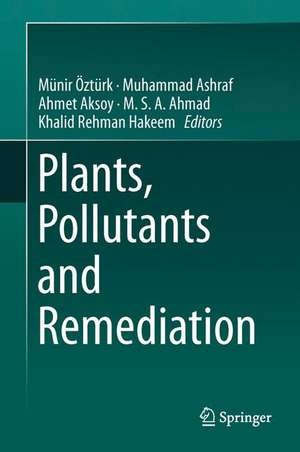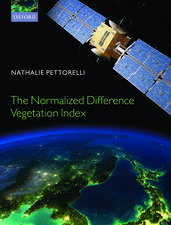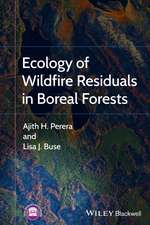Plants, Pollutants and Remediation
Editat de Münir Öztürk, Muhammad Ashraf, Ahmet Aksoy, M. S. A. Ahmad, Khalid Rehman Hakeemen Limba Engleză Hardback – 20 ian 2016
This volume therefore covers discussions on the recent developments in this connection and the emerging role of plants as indicators, remediation, and such related issues as biodiversity conservation and the effects of on edible plants. It reviews issues concerning the future of plant life. Taking cognizance of this, several experts from different parts of the globe have contributed from their experience and knowledge to the critical issues of "Environmental Pollution," and the "Role of Plants in this connection”.
Toate formatele și edițiile
| Toate formatele și edițiile | Preț | Express |
|---|---|---|
| Paperback (1) | 570.05 lei 38-45 zile | |
| SPRINGER NETHERLANDS – 31 mar 2018 | 570.05 lei 38-45 zile | |
| Hardback (1) | 659.20 lei 3-5 săpt. | |
| SPRINGER NETHERLANDS – 20 ian 2016 | 659.20 lei 3-5 săpt. |
Preț: 659.20 lei
Preț vechi: 775.53 lei
-15% Nou
Puncte Express: 989
Preț estimativ în valută:
126.14€ • 134.89$ • 105.17£
126.14€ • 134.89$ • 105.17£
Carte disponibilă
Livrare economică 28 martie-11 aprilie
Preluare comenzi: 021 569.72.76
Specificații
ISBN-13: 9789401771931
ISBN-10: 9401771936
Pagini: 300
Ilustrații: XV, 404 p. 133 illus., 28 illus. in color.
Dimensiuni: 155 x 235 x 28 mm
Greutate: 0.94 kg
Ediția:1st ed. 2015
Editura: SPRINGER NETHERLANDS
Colecția Springer
Locul publicării:Dordrecht, Netherlands
ISBN-10: 9401771936
Pagini: 300
Ilustrații: XV, 404 p. 133 illus., 28 illus. in color.
Dimensiuni: 155 x 235 x 28 mm
Greutate: 0.94 kg
Ediția:1st ed. 2015
Editura: SPRINGER NETHERLANDS
Colecția Springer
Locul publicării:Dordrecht, Netherlands
Public țintă
ResearchCuprins
1. Visible Injury, CO2 Assimilation and PSII Photochemistry of Eucaliptus Plants in Response to Boron Stress.- 2. Vanadium in the Environment and its Bioremediation.- 3. Nitrogen pollution, Plants and Human health.- 4. Evaluation of Wild Halophytes of Aralo-Caspian flora towards Soil Restoration and Food Security Improvement.- 5. Nickel Metal Uptake and Metal-Specific Stress Alleviation in a Perennial Desert Grass Cenchrus ciliaris.- 6. Taming Food Security through Wastewater Irrigation Practices.- 7. The potentiality of wastewater use for irrigation in Turkey.- 8. Plant secondary metabolites: deleterious effects, remediation.- 9. Genotoxic Effects of Boron on Chickpea (Cicer arietinum L.) and Tomato (Solanum lycopersicum L.).- 10. The Method of Dynamic Factors in Bioindication and Phytoremediation.- 11. Plant-Pollutant Interaction.- 12. Plants for remediation: uptake, translocation and transformation of organic pollutants.- 13. Potential Use of Licorice in Phytoremediation of Salt Affected Soils.- 14. Effect of Nutrient Enrichment on Metal Accumulation and Biological Responses of Duckweed (Lemnaceae) Spread in Turkey.- 15. Temporal variation of biological oxygen demand (BOD), chemical oxygen demand (COD), and pH values in surface waters of Gölcük-Kocaeli, Turkey.- 16. Ambient Ozone Levels in the Eastern Mediterranean Region and Assessment of its Effect on the Forested Mountain Areas of Southern Turkey.- 17. Determination of environmental activities and perspectives of plants: a field research in Kayseri.- 18. An approach for sustainable management of the Balıklıgol Lakes, Turkey.- 19. Kinetics and Mechanisms of Biosorption of Copper Ion onto Waste Yeast (S. Cerevisiae).- 20. Effects of Air Pollution on Urban Plants: Nezahat Gökyiğit Botanical Garden.
Textul de pe ultima copertă
Environmental remediation technology has become a rapidly emerging branch of science in the 21st century. This technology is helping many branches of life sciences in solving the problems. This book therefore presents a holistic view of the complex and dynamic responses of our biodiversity to environmental pollution and their remediation strategies, in particular plant eco physiological adaptations which vary from species to species. The topics in this book are discussed to enlighten adaptation strategies to circumvent the negative impacts of polluting factors based on a large number of observations. The growing number of findings in this field are producing several applications in the fields of remediation of polluting factors in the environment. The book discusses the topics like; plant-pollutant interactions, the visible injury in response to boron stress and its genotoxic effects, bioremediation of vanadium, nitrogen pollution, plants and human health, role of halophytes towards soil restoration, nickel uptake, taming food security through wastewater irrigation and its potentiality, deleterious effects and remediation of secondary metabolites in forages, biosorption of copper using waste yeast, liquorice in the remediation of saline soils, role of duckweed in metal accumulation, temporal variations in different environmental parameters, urban plants and air pollution, bioindication and phytoremediation, plants for remediation of organic pollutants. The book also enlightens the research gaps which need to be bridged to achieve larger goals concerning the applications of remediation technology.
Caracteristici
Covers recent updates in biochemical, metabolic and physiological responses of plants to pollutants and tolerance mechanisms Summarise approaches for the use of phytoremediation as a potential source for amelioration of contaminated soils Understanding physiological basis of metal stress-induced damages in crops and, trees while devising a practical measure to avert the problem












